Integrated Circuit Image Gallery
Intel 486DX4 Microprocessor
Despite the name, the Intel 486DX4 microprocessor does not run internally at four times the memory bus speed, but rather at triple the external clock speed. Since Intel reserved the "DX3" designation for a 2.5 times clock multiplier that never reached the marketplace, they had to create the newer moniker, the "DX4". Although Intel never produced one, clone makers such as Advanced Micro Devices (AMD) and Cyrix sold 5x86 central processing units (CPUs) that were actual clock quadruplers.

View a second image of the Intel 486DX4.
Responding to competitive pressures and advancing silicon fabrication techniques, Intel released faster and more powerful 486DX4 chips. After their initial 50 MHz-clock-speed version in 1989, the DX2 at 66 MHz clock speed and the first 75 MHz 486DX4s were produced in 1994. Finally, in 1996, Intel shipped the 486DX4-100 MHz processors with a write-back memory cache. Previously, Intel had produced the only 486DX4 CPU with near-obsolete write-through-only cache. Other advances included reducing the waste power dissipation from a typical 3.7 watts down to a more acceptable 2.8 watts. The reduced voltage requirements permitted the 486DX4 chips to match new battery-powered laptop personal computers and to garner favor as environmentally friendly "green machines" when powering desktop computers.
The Intel 486DX4 initially featured an 8-kilobyte cache memory, followed by 16 kilobytes that matched slower memory systems while yielding a 25 percent gain in overall performance. To achieve the larger cache size, Intel design engineers had to support a higher clock speed and higher transistor count using new design rules that reduced the 0.8-micron technology of the DX2 series down to 0.6 microns. In the SL-enhanced version of the DX4 microprocessor, Intel chips featured low voltage demands and power management modes that better suited portable battery-powered laptops than the older 5-volt designs. With 1.6 million transistors and 32-bit register, address and data buses, Intel was able to boost the performance of the basic 486 design while maintaining compatibility with older support circuitry, microprocessors, and software.
Contributing Authors
Omar Alvarado, Thomas J. Fellers and Michael W. Davidson - National High Magnetic Field Laboratory, 1800 East Paul Dirac Dr., The Florida State University, Tallahassee, Florida, 32310.
BACK TO THE INTEGRATED CIRCUIT IMAGE GALLERY
BACK TO THE DIGITAL IMAGE GALLERIES
Questions or comments? Send us an email.
© 1995-2025 by Michael W. Davidson and The Florida State University. All Rights Reserved. No images, graphics, software, scripts, or applets may be reproduced or used in any manner without permission from the copyright holders. Use of this website means you agree to all of the Legal Terms and Conditions set forth by the owners.
This website is maintained by our
Graphics & Web Programming Team
in collaboration with Optical Microscopy at the
National High Magnetic Field Laboratory.
Last Modification Friday, Nov 13, 2015 at 01:19 PM
Access Count Since September 17, 2002: 8679
Visit the website of our partner in introductory microscopy education:
|
|
